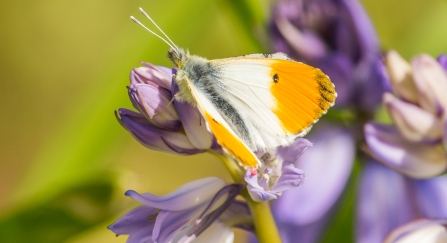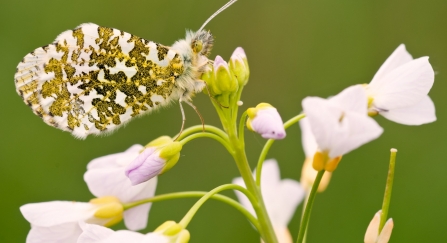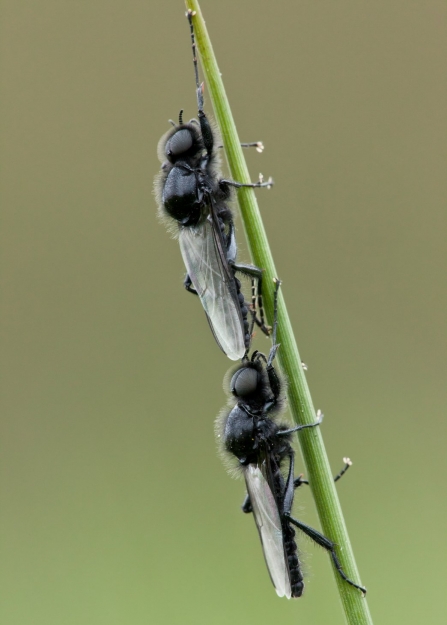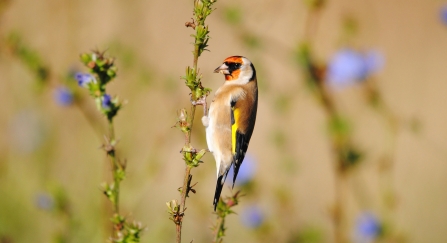There’s a bench. It’s a nice bench. It’s at the top of the island. Visitors often take a moment to relax there and take in the view.
Photo of bench
You don’t usually see whimbrels resting there.
But we did! Sorry no photo of Whimbrel on the bench, so you’ll just have to enjoy this one having a rest on the beach:
Photo of whimbrel resting
The teeny weeny stuff
This week we’ve been catching glimpses of gorgeous Orange Tip butterflies – the males white butterflies with, of course bright orange wingtips. The females however, like to create more of an ID challenge so, despite their name, they have dark grey, not orange wingtips.

Orange tip male showing orange tips - Janet Packham Photography
The best part though is their underwings. I just love them as they are a wonderfully mottled mossy green.

Photo Orange tip underwing - Ross Hoddinott/2020VISION
Did you know that butterflies can taste through their feet? That’s a bit weird isn’t it? The female uses her feet's taste sensors to check if a plant is suitable before she lays her eggs. Then she’ll just lay one egg per plant stem. Why one egg? It’s because when they hatch out the caterpillars first eat their own eggshell then go on to eat other nearby Orange tip eggs. So yes, these pretty little creatures are cannibalistic – gross!

St. Mark's flies (Bibio marci) - Guy Edwardes/2020VISION
Now I know some people find this strange, but there’s a fly out there that’s quite cute. It’s because it’s hairy and shiny and the male has really large eyes. It’s the St Marks Fly. The other cool thing about it is that, like clockwork it emerges on St Mark’s Day – which is April 25th and is how it got its name. And guess when I spotted this fly? Yep, 25th. As I said, like clockwork.
They are quite common too. You see lots of them hanging in the air with their long legs dangling beneath them. Apparently the male’s eyes are divided so that they use the upper part to look out for females and the lower part to monitor their position in relation to the ground. This allows them to appear super laid back as they hover in the hope of attracting a female. In my mind that makes them cute and cool and clever too. Oh and the adults feed on nectar making them important pollinators, while the larvae fed on rotting vegetation making them useful decomposers. All hail the St Mark’s fly!
The greeny stuff
A small two-tone pinky flower keeps catching my eye.
Fumitory
It’s a type of fumitory.
Close up the tubular flowers are almost lilac with deep burgundy red tips. They make me think of raspberry ripple ice-cream!
Fumitory is often seen as a just a weed. They say a weed is just a plant growing in the wrong place and in my opinion there’s no wrong place for this pretty little flower. To me fumitories are delicate well hidden treasures that are a treat to find entwined amongst the vegetation. Being hard to discover means that it often goes unnoticed by insects too. So, rather than rely on insects, it cuts out ‘the middle man’ and has to self-pollinate to produce seeds.
Wild garlic through the woods
Now, I’ve been really looking forward to talking all things stinky and Wild Garlic (aka Ransoms). Wild garlic is such a great plant. When it’s in flower it covers the ground in what looks like a carpet freshly fallen snow. You can’t avoid releasing the pungent odour as you walk along some of the island’s paths and the aroma is so strong it stays on our clothes when we return to the cottage.
Close up of wild garlic flower
Wild garlic produces a cluster of starry flowers early in spring, so is an important early bloom for the bees and other pollinating insects. It’s a popular plant with larger animals too – yes human foragers. Jon and I enjoy the mild oniony-garlic taste of the leaves stirred through sauces and mixed in with salads. On the continent the bulbs are said to be a favourite food of wild boar and brown bear. Hence its scientific name, Allium ursinum (bear leek or bear garlic). The snow, stars, bear and boar plant – just magical.
The feathery stuff
Canada Goose on sea
Meet Gloria the Canada Goose – during the day she hangs out here with one other goose (Gilbert)… and all the gulls. They noisily fly between here and the mainland and always make me smile.
Canada Geese are a marmite bird – as you either love ‘em or hate ‘em.
You see they aren’t native to the UK. In fact they were brought here in the late 1600s by King James II's as he thought they’d look nice on the lake in St. James's Park, London. And look good they do – I think they are bold and beautiful birds But their numbers have boomed and they’ve spread across the UK. And here comes the problem – they tend to come together in large flocks and just love lawns, parks, golf courses and airports… it’s the short grass you see. They just love grazing on grass. The short vegetation also means they can easily spot approaching predators. But all those geese happily munching away on carefully tended grasses means only one thing – lots of poo! It’s like they are taking advantage of the spaces created by us humans and leaving they place a right old mess. That and the fact they are so noisy is very anti-social behaviour indeed. Still at the moment Gloria and Gilbert are very welcome here.
Over the winter we get huge of flocks of hundreds of finches roosting in the bare tree tops. In the evenings there’ll be chaffinch, greenfinch and goldfinch swirling around the skies looking for the perfect spot to spend the night. A favourite has to be the goldfinch. Did you know that the collective term for goldfinches is a charm? A beautiful term for a strikingly colourful bird.

Goldfinch - Amy Lewis
Now Spring is here, many of the finches are nesting. This means we see smaller numbers flitting about at any one time. Having said that, with the goldfinches you hear them first. They sound like liquid twittery tinkling bells with an occasional whizzy flourish! In fact I can hear them in the garden as I type and it really is lovely.
As well as dashing around the trees the goldfinches like feeding on the teasel and thistles. And, fascinating fact time – in Anglo-Saxon times a goldfinch was known as Thisteluige and it translates as thistle-tweaker – cute!
The salty stuff
I found my first ever Strawberry anemone this week!
I was actually looking for sausages (a story for another day) but I found a strawberry instead.
Strawberry anemones are quite common it’s just that I’ve never found one before. Found lots of beadlet and snakelocks anemones but never a strawberry. Happy!
Now, you’d never have thought it but these creatures know how to give a good fight. They are highly territorial. They have a ring of beads beneath their tentacles called acrorhagithat (that’s another word to add to the unpronounceable list) which are packed full of stinging cells. They use these beads to fight off other anemones and defend their preferred patch. So, don’t mess with the strawberries, right?!
From these blogs you’ll already have learnt that I love seals. You’ll also have learnt that the main seal that we get here is the grey seal. But have you learnt their scientific name? No? It’s a good one. It’s Halichoerus grypus – it means hooked-nosed sea pig!
Sometimes when I’m watching the seals I’ll spot one that lives up to its name. It’s usually a male. Like this one:
Male grey seal with classic roman nose
I always think the adult males look like a boxer or maybe a prop forward rugby player? Compared to females they have thicker necks and more of a ‘roman nose’. And here’s an impressive fact, with adult males weighing up to 350kg and being up to 2.8m long they are the UKs largest land-breeding animal. Wow – but wait a minute did I say land animal? Yep, although they spend lots of time in the sea they come ashore to rest, moult and to breed. So there you go, a marine mammal that pups on land – cool!
Coming soon…
I’ve teased you long enough, it has to be
- Oystercatchers
- Rambling red champion
- And I’m darned if I don’t find a marvellous moth to share
Rainbow over the mainland

